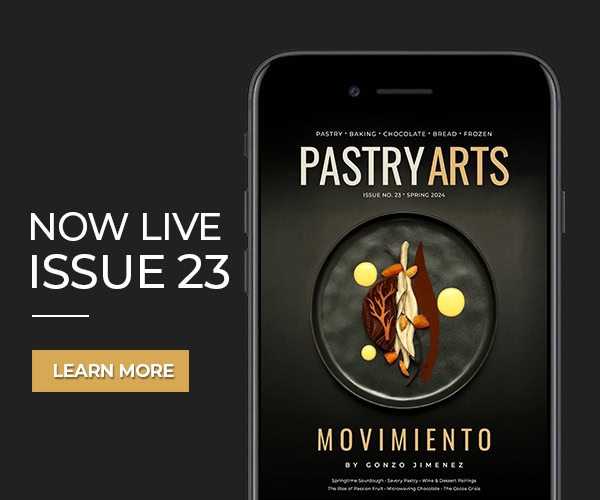By Tom Hemerka
As chefs, we can often romanticize about the way something is prepared or the techniques that make something special, and we can put our sense of pride in the products we make and the ingredients we buy, but it’s not every day that we can take the time away from the kitchen to visit the farm or our vendors. For most of us, chocolate is something we became passionate about once we got our hands on it. It can be used to create beautiful showpieces and can equally be admired for its technical elements and the mindset needed to develop recipes and formulas. One of the first books I picked up on the matter was Ramon Morato’s book Chocolate, and it totally changed me and the way I saw chocolate. There were many ideas and visions planted in my head after reading it, and one of them came true for me and a lucky group of pastry chefs, chocolatiers and ice cream makers this year.
Mid-January started the discussions of a project that our group knew was by far going to be the most eye-opening experience for us yet, the experience of a lifetime: Visiting a chocolate company from Ecuador called Republica del Cacao, which we were scheduled to tour around the beginning of the first harvest season. The anticipation made for a long wait prior to travel, but it was well worth it. Upon our arrival, we traveled into the heart of the country, Quito, where we’d find an unassuming building exterior and gated entry which led us to their manufacturing facilities. Inside was a small, but extremely passionate team that’s managing to produce chocolate for artisans at a global scale.
Immediately feeling at home, the team gave us a brief synopsis of the day before whisking us away to explore their facilities. We wouldn’t realize it until later, but one of the most fascinating segments of the tour was at the start, when Republica del Cacao’s (RDC) CEO, Arnaud Monmarche, spoke to us about the company’s receiving procedure. We were told that as a new chocolate origin is being developed, there’s roughly eight months of testing each harvest to ensure they can create a stabilized fermentation and flavor profile, and that on average, it will take each new farmer between one to one and a half years to become validated partners. Before each bag of cacao beans is confirmed, they pull a sample of those beans to be split in half. After those beans are split to examine the color, which ranges from purple (shorter fermentation) to brown (longer fermentation).
Preceding this stage, the beans travel to the other side of the facilities and continue building on the complexity of flavors with the beginning of the roasting process. As we entered the roasting room, we saw a structure that stood 12-feet high and 10-feet deep, with a large hopper on the top and a drum on the bottom that stirs and dispenses the beans. Each type of origin will have its own individual roasting times, but something that is more consistent is the roasting temperatures which generally range from 248 to 257 degrees F (120 to 125 degrees C).
From the roasting stage, the beans are taken to a separate room where the beans are processed to create the nibs. Over the course of our trip, there were a few places where we could jump in and “get our hands dirty,” this being one of them. The machine in this room had a much larger hopper to hold all of the beans. Once in the hopper, the beans were forced through a mechanism to crush and dispense them down a vibrating/perforated slide to separate the nibs from the hull. This is the task where our labor contribution would lie, the loading of the cacao. This may seem like a small job, but there’s no replacement for the connection you get from an experience of doing something with your own two hands.
Something we wouldn’t have otherwise known is that once the cacao is separated from the hull, the hulls are then collected and used to make an alcohol byproduct that’s consumed across Ecuador. Unfortunately we didn’t get to see or taste this product, so we’ll have to imagine its taste.
Next stop was the conching machine. This machine did not function or look the same way as the traditional conching machines you may be familiar with. In this instance, there were no spinning stones going round in circles crushing nibs, but rather a 10-foot tall, fully enclosed drum. As this stage’s chocolate-making process was being described to us, we were able to walk up the steps and take a look inside this drum. We were surprised to see what we can only describe as what looked like fan blades similar to an airplane’s engine. If you’ve made ice cream in a batch freezer and looked inside while it’s spinning, that’s exactly what this looked like, except…chocolate. One detail about the process and the machine we were naive about in this stage was the importance of ventilation. The friction applied during this stage generates a fair amount of heat that will change the chemical nature of the beans and release aromas that would otherwise be trapped and result in an overly acidic product. Because the friction creates heat and changes flavor, the other added ingredients (sugar, dairy, and cocoa butter) are added at different stages of the refining process. The ultimate goal besides having a great tasting chocolate is also to have a chocolate with a great mouthfeel. To achieve this, all companies measure the particle size and aim for something in the range of 20-30 microns, which makes the chocolate particles virtually unnoticeable on the palate.
For RDC, once the chocolate reaches 40 microns, they stop the conching process and pump the chocolate through what looked like 30 feet of piping to the tempering machine and begin the crystallization process. (Fun fact: One of the benefits of refining the chocolate further is that it increases the fluidity of the chocolate due to the increased surface area of the cocoa butter particles.) While we were unsure about the capacity of the chocolate tank, you would be fascinated to see the size of the depositor’s head. Roughly seven feet wide and one foot deep, this head was depositing 300-plus drops in one shot – THAT’S A LOT OF CHOCOLATE. Once the chocolate hit the belt, it traveled down the temperature-controlled cooling tunnel, which had to be no shorter than 50 feet long, before merging the drops onto a narrower belt which ultimately fed straight into their packaging machinery.
As we left the building, we had the opportunity to spend more time with the company’s employees, who help make it such a special place. While we touched on the relationships the company has with its farmers, this story goes much deeper and is a part of RDC’s DNA. RDC has worked so hard to develop those relationships and make an impact on the people they touch, they’ve received a ‘B Corp’ certification. The two most popular types of corporations you’ve probably heard of are S or C Corps. Companies that choose these types of business structures will benefit from its tax laws and liability protection and are almost entirely profit-driven. When it comes to B Corps, they will share similar liability protections as an S or C Corp, but will bear additional responsibilities for public transparency, and work to make positive social impacts while they make money. An example of a company like this you may be more familiar with is Tom’s – they’re known for giving away a pair of shoes for every pair they sell. Since RDC sources their chocolate, sugar, and dairy from within the country, they hold an enormous opportunity to impact the well-being and economic growth of the farming communities they work with.
While there’s an abundance of other wonderful things we can go on about with this company and trip, we wanted to leave out the part where we tasted the range of chocolates RDC produces to leave it up to your imagination. If our story has compelled you in any way, we’d highly recommend you reach out to your purveyors and get yourself a few samples (especially the 40% milk chocolate).
About the Author
Tom Hemerka is the founder of Pastry Elite™, a source for pastry news, unique perspectives, new techniques and insight from the top pastry chefs around the world. Connect with Pastry Elite via the website (www.pastryelite.com), or on Instagram (@pastryelite), Facebook or Twitter.





You must be logged in to post a comment.